With Amazon Lex Chatbots and Contact Lens, you can create tomorrow’s customer experience today.

Go to almost any website today, and chatbots are ubiquitous, whether online or when a customer calls the customer service number. Consumers both expect them and view them with dread. They can be a great resource that quickly answers questions intuitively and competently, or they can lead the user down a garden path that ends in frustration. The latter is the more common scenario, but there’s encouraging news on the horizon: These robots are becoming less robotic, and they are set to see significant improvement.
Artificial intelligence (AI) is powering change in chatbots that will make them more intelligent, excellent conversationalists, a bit more human, and markedly more helpful. However, even today’s chatbots have revolutionized the call center experience for both agents and consumers. They’ve also helped increasing numbers of companies save money while offering 24/7, 365-day service.
For users of Amazon Connect, the future is available today. With Amazon Lex, you can build chatbots with conversational AI that understands intent, maintains context, and automates simple tasks in many languages. Paired with Contact Lens for Amazon Connect, you can build an efficient experience that increases customer satisfaction through machine learning-powered speech analytics that inform agent interactions as well as your bot’s responses. Let’s take a look at how you can use these tools to transform your call center experience.
The rise of the chatbot
Because chatbots can shoulder a big load when it comes to customer support operations, they’re the fastest-growing channel in brand communications. In 2019, chatbots were used by consumers 13% of the time, but just a year later, 24.9% were using them, up 92%. Millennials in particular are heavy chatbot users, and it’s predicted that industries that cater to them will see an increase to 70% of interactions by the end of 2022.
As chatbots have improved, end-to-end resolution has increased. In 2017, only 20% of chats could be handled completely without help from an agent. By 2019, that number reached 68.9%. But just why do consumers interact with chatbots? One reason is that they get a quick answer, and as we know, consumers want it, and they want it now – 45.9% expect chatbots to deliver an immediate response.
But AI chatbots can handle more than questions; they engaged, drove conversions, and closed sales for 41.3% of users. The response rate for bots is great too at 35% to 50% on the low end and 80% to 90% at the top. The average satisfaction rate of end-to-end bot chats is 87.58%.
Now let’s talk about implementing your own bots to create the customer service center of the future with Amazon Lex and Contact Lens.
Amazon Lex chatbots with conversational AI
Complete instructions on how to create Lex chatbots can be found here. Let’s explore the features and use cases, and then we’ll talk about how Contact Lens can make your bots not only better over time but improve the entire customer experience.
- You can easily add AI that understands intent, maintains context, and automates simple tasks.
- You can design and deploy omnichannel conversational AI in one click.
- Lex connects seamlessly with other AWS services so you can query data, execute business logic, and monitor performance.
Build virtual agents and voice assistants that bypass human agents, automate informational responses for frequently asked questions across company departments, and use existing contact center transcripts to accelerate your bot deployment.
How it works and key features of Lex chatbots
Lex uses the same technology as Alexa and provides the tools to solve deep learning problems, such as speech recognition and language understanding, through an easy-to-use, fully managed service. It integrates with AWS Lambda, which you can use to trigger functions for executing back-end business logic for data retrieval and updates. Once you build your AI chatbot, it can be deployed directly to chat platforms, mobile clients, and IoT devices. The reports provided can be used to track metrics.
Here are the key features that make Lex chatbots such a valuable asset to your call center:
1. High-quality speech recognition and natural language understanding: As we mentioned, Lex is powered by the same technology as Alexa, so it can learn the various ways users express intent based on a few sample utterances provided by the developer. Then, the speech language understanding system takes natural language speech and text input, understands the intent behind the input, and fulfills the user intent by invoking the appropriate response.
2. Context management: Context management is supported natively, so it can be managed directly without custom code. As initial prerequisite intents are filled, you can create “contexts” to invoke related intents. This simplifies bot design and speeds up the creation of conversational experiences.
3. 8 kHz telephony audio support: The Amazon Lex speech recognition engine has been trained on telephony audio (8 kHz sampling rate) to provide increased speech recognition accuracy for telephony use-cases.
4. Multi-turn dialog: Once an intent has been identified, users are prompted for information that is required for the intent to be fulfilled. You get an easy way to build multi-turn conversations for your AI chatbots. Simply list the slots/parameters you want to collect from your bot users, as well as the corresponding prompts, and Amazon Lex takes care of orchestrating the dialogue by prompting for the appropriate slot.
Now, let’s talk about how Lex bots combined with Contact Lens for Amazon can take your customer service to a whole new level.
Making the most of Lex bots with Contact Lens
You can transform your Amazon Connect contact center with the power of Contact Lens for Connect and Amazon Lex bots to increase the depth of your insights and the quality of your customer service experience with well-designed and strategically implemented AI.
Contact Lens for Amazon Connect helps you follow the sentiment and trends of customer conversations in real-time to identify important company and product feedback. You can also:
- Track agent compliance during customer conversations in your contact center.
- Replicate successful interactions.
- Conduct a full-text transcript search to quickly troubleshoot customer issues.
- Use real-time analytics powered by machine learning (ML) to be alerted to issues during live customer calls and deliver coaching to agents while calls are in progress, improving customer satisfaction.
Amazon Connect customers using Contact Lens can directly use conversation transcripts in their original format. By importing transcripts, you can use the Amazon Lex V2 console to build bots quickly. Amazon Lex V2 provides the deep functionality and flexibility of natural language understanding and automatic speech recognition, so you can build highly engaging user experiences with lifelike, conversational interactions and create new categories of products.
By using the insights collected from both Lex bots and Contact Lens, your customer service satisfaction will increase exponentially. Use the power of AI to create tomorrow’s efficient, intuitive call center today.
Create your call center of tomorrow with CloudHesive
We’re a cloud solutions consulting and managed service provider with expertise in all things Amazon Web Services. We have eight AWS Competencies, more than 50 AWS Certifications, membership in nine Partner Programs, and the experience and knowledge to help your business realize all the benefits of AWS cloud.
We’ve helped more than 100 companies reduce their operating costs and increase productivity with our focus on security, reliability, availability, and scalability. With over 30 years of experience, we leverage cloud-based technology to its full potential. Contact the CloudHesive team today.



